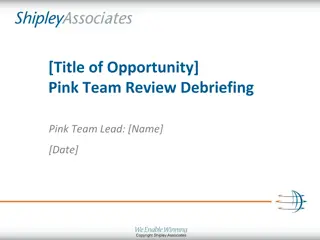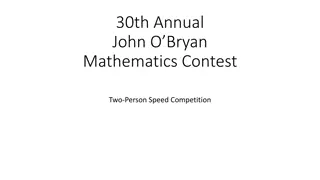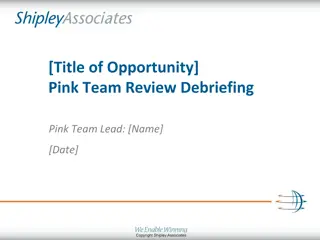Contest Debriefing: Scientific Committee Summary
The contest debriefing conducted by the Scientific Committee reviewed the performance of 50 teams in the first 4 hours. The teams tackled various challenging problems related to free food, SG Coin, non-prime factors, hopper, largest triangle, bitwise operations, conveyor belts, prolonged password, and magical string. The debriefing includes detailed analysis of solved and attempted problems, along with insights from authors and testers.
Download Presentation

Please find below an Image/Link to download the presentation.
The content on the website is provided AS IS for your information and personal use only. It may not be sold, licensed, or shared on other websites without obtaining consent from the author.If you encounter any issues during the download, it is possible that the publisher has removed the file from their server.
You are allowed to download the files provided on this website for personal or commercial use, subject to the condition that they are used lawfully. All files are the property of their respective owners.
The content on the website is provided AS IS for your information and personal use only. It may not be sold, licensed, or shared on other websites without obtaining consent from the author.
E N D
Presentation Transcript
Contest debriefing Scientific Committee
Result Total: 50 teams First 4 hours only A B C D E F G H I J K L 18/97 (19%) 3.73 3.22 38/71 (54%) 1.69 1.63 43/93 (46%) 1.98 1.98 7/33 (21%) 2.75 3.14 0/7 (0%) 1.75 - 20/44 (45%) 1.76 1.75 8/18 (44%) 2.00 2.12 3/10 (30%) 1.43 1.67 4/10 (40%) 1.67 1.75 47/49 (96%) 1.04 1.04 7/12 (58%) 1.50 1.57 41/117 (35%) 2.34 1.78 Solved / Tries Average tries Averages tries to solve Problem J: Free Food Problem C: SG Coin Problem L: Non-prime factors Problem B: Hopper Problem A: Largest Triangle Problem D: Bitwise Problem K: Conveyorbelts Problem I: Prolonged Password Problem E: Magical String (For problems G, H, F, please read the solution by yourself ) Ken Felix Suhendry
Free Food Problem J Author: Dr. Suhendry Effendy (NUS) Tester: Dr. Felix Halim (Google), Dr. Steven Halim (NUS)
Problem Input: N intervals (1 N 100) Output: the number of days in which free food is served. 1 2 3 4 5 6 7 364 365 0 1 1 1 1 0 1 0 0
Solution Note that there are only 100 intervals and each interval is of length at most 365. We use brute-force solution. Initialize the bit array B[1..365] as zeros For each interval (si, ti), mark B[si..ti] = 1. Report the number of bits B[i] equal 1 1 2 3 4 5 6 7 364 365 0 0 0 0 0 0 0 0 0
Solution Note that there are only 100 intervals and each interval is of length at most 365. We use brute-force solution. Initialize the bit array B[1..365] as zeros For each interval (si, ti), mark B[si..ti] = 1. Report the number of bits B[i] equal 1 1 2 3 4 5 6 7 364 365 0 1 1 1 0 0 0 0 0
Solution Note that there are only 100 intervals and each interval is of length at most 365. We use brute-force solution. Initialize the bit array B[1..365] as zeros For each interval (si, ti), mark B[si..ti] = 1. Report the number of bits B[i] equal 1 1 2 3 4 5 6 7 364 365 0 1 1 1 1 0 0 0 0
Solution Note that there are only 100 intervals and each interval is of length at most 365. We use brute-force solution. Initialize the bit array B[1..365] as zeros For each interval (si, ti), mark B[si..ti] = 1. Report the number of bits B[i] equal 1 1 2 3 4 5 6 7 364 365 0 1 1 1 1 0 1 0 0
SG Coin Problem C Author: Dr. Felix Halim (Google) Tester: Dr. Suhendry Effendy (NUS), Dr. Steven Halim (NUS)
Problem Given a block Z with HashValue Z (with 9 digits and 7 trailing zeros), you need to generate two blocks A and B such that A=H( Z,SA,TA) has 9 digits and 7 trailing zeros; and B=H( A,SB,TB) has 9 digits and 7 trailing zeros. prevHashValue: Z Transaction: SA Token: TA HashValue: A=H( Z,SA,TA) prevHashValue: A Transaction: SB Token: TB HashValue: B=H( A,SB,TB) prevHashValue: ?? Transaction: ?? Token: ?? HashValue: Z Block Z Block A Block B
Simple solution 1. Randomly generate SA and TA. 2. Compute A=H( Z,SA,TA) 3. Randomly generate SB and TB. 4. Compute B=H( A,SB,TB) 5. Output SA, TA, SB, TB. The running time is slow since you need to compute H(). prevHashValue: Z Transaction: SA Token: TA HashValue: A=H( Z,SA,TA) prevHashValue: A Transaction: SB Token: TB HashValue: B=H( A,SB,TB) prevHashValue: ?? Transaction: ?? Token: ?? HashValue: Z Block Z Block A Block B
Speedup 1: Use a short The running time of H() depends on the length of transaction. So, we use one character X for transaction. 1. Randomly generate TA. 2. Compute A=H( Z, X ,TA) 3. Randomly generate TB. 4. Compute B=H( A, X ,TB) 5. Output X , TA, X , TB. prevHashValue: Z Transaction: X Token: TA HashValue: A=H( Z, X , TA) prevHashValue: A Transaction: X Token: TB HashValue: B=H( A, X , TB) prevHashValue: ?? Transaction: ?? Token: ?? HashValue: Z Block Z Block A Block B
Observation Since all HashValues have 9 digits and 7 trailing zeros, there are 99 different HashValues: 010000000 020000000 030000000 990000000
Build Lookup table Token For each hashValue , we find a token such that 990000000=H( , X , ). 000000000 000000001 000000002 999999998 999999999 HashValue 010000000 020000000 030000000 980000000 990000000 T[ ]= such that 000000000=H( , X , ) Since there are only 100 HashValues, we can precompute a table T[] where T[ ] equals the token such that 990000000=H( , X , )
Solution If the hashValue of block Z is Z, the output is X , T[ Z] X , T[990000000] By table lookup, O(1) time. prevHashValue: Z Transaction: X Token: T[ Z] HashValue: 990000000=H( Z, X , T[ Z]) Block A prevHashValue: ?? Transaction: ?? Token: ?? HashValue: Z Block Z prevHashValue: 990000000 Transaction: X Token: T[990000000] HashValue: 990000000=H( A, X , T[990000000]) Block B
Remark Accidentally, this problem is very similar to the problem H in Yangon 2018 (on last Sunday, 9 Dec). Note that we submit the problem last month. This is just a coincidence.
Non-Prime Factors Problem L Author: Dr. Steven Halim (NUS) Tester: Dr. Felix Halim (Google), Dr. Suhendry Effendy (NUS)
Problem Input: an integer i Output: NPF(i), which is the number of non-prime factors of i. Example: i = 40. 40 has 8 factors: 1, 2, 4, 5, 8, 10, 20, 40. 40 has 2 prime factors: 2, 5. 40 has 6 non-prime factors: 1, 4, 8, 10, 20, 40. NPF(40)=6.
Theorem The prime factorization of i = ?1?1?2?2 ????. Then, the number of factors of i = (q1+1)(q2+1) (qm+1). The number of prime factors of i = m. The number of non-prime factors of i = (q1+1)(q2+1) (qm+1) - m. Example: i = 40 = 23*51. 40 has 8=(3+1)*(1+1) factors: 20*50, 20*51, 21*50, 21*51, 22*50, 22*51, 23*50, 23*51. 40 has 2 prime factors: 20*51, 21*50. 40 has 6=(3+1)(1+1)-2 non-prime factors: 20*50, 21*51, 22*50, 22*51, 23*50, 23*51.
Solution Given a number i, For p = 2 to ? Check if p is a prime factor if i. Then, we obtain the prime factorization of i = ?1?1?2?2 ????. This takes O ? time. After that, report NPF(i) = (q1+1)(q2+1) (qm+1) - m.
Another solution Given a number i, Find all non-prime factors of i using a modified sieve of eratosthenes algorithm Basically, run sieve of eratosthenes algorithm but cross out all the prime number Then, we count the number of non-prime numbers
Further speedup It is still not fast enough! Speedup 1: File I/O is slow. C language: Instead of using cin/count, use scanf/printf. Java language: Instead of using Scanner/System.out.println, use BufferedReader/PrintWriter.
Further speedup Speedup 2: Observe that There are at most 3*106 queries. The maximum value of i is 2*106. By pigeon-hole principle, some queries NPF(i) are duplicates. To save computational time, you can store the answers in a hash table.
Remark Since this question requires a lot of I/O, python will die miserably.
Hoppers Problem B Author: Hubert Teo Hua Kian (Stanford University) Tester: Dr. Suhendry Effendy (NUS), Dr. Steven Halim (NUS)
Problem Input: An undirected network with N nodes and M edges Malware hopper : If a node is infected, its neighbors neighbors will be infected. A network is unsafe if one node v is infected by hopper , all nodes in the network will be infected. Output: The minimum of number of additional edges to make the network unsafe. Example 1: Add zero edge to make G unsafe. If we infect node 1, Node 2 will be infected since 1-5-4-3-2 is of even length. Node 3 will be infected since 1-2-3 is of even length. Node 4 will be infected since 1-5-4 is of even length. Node 5 will be infected since 1-2-3-4-5 is of even length. 1 1 2 2 3 3 5 5 4 4
Problem Example 2: The original graph G is safe. If we infect node 1, Node 3 will be infected since 1-2-3 is of even length. Cannot further propagate. If we infect node 2, Node 4 will be infected since 2-3-4 is of even length. Cannot further propagate. 1 2 4 3 After we add 1 edge (1, 3), G is unsafe. If we infect node 1, Node 2 will be infected since 1-3-2 is of even length. Node 3 will be infected since 1-2-3 is of even length. Node 4 will be infected since 1-3-2 is of even length.
Idea 6 6 Lemma: If G does not have odd cycle, then G is safe. 1 1 2 2 5 5 Proof: If G does not have odd cycle, then G is 2-colorable, say red and blue. If you infect a red node, all red nodes will be infected but not blue nodes. If you infect a blue node, all blue nodes will be infected but not red nodes. So, G is safe. 4 4 3 3 10 10 7 7 9 9 8 8
Idea Lemma: Consider an odd cycle 1 2 3 n. For any node j, Either 1-2-3- -j or 1-n-(n-1)- -j is of even length. 1 1 Proof: For odd j, 1-2-3- -j is of even length. For even j, 1-n-(n-1)- -j is of even length. n n 2 2 n-1 n-1 3 3 4 4 5 5
Idea Lemma: Suppose the graph G is connected and has an odd cycle. G is unsafe. After we infect a node v in the odd cycle, all nodes will be infected. 1 1 n 2 Proof: Let 1-2- -n be the odd cycle in G. For any node u in G, either 1-2- -j- -u or 1-n-(n-1)- -j- -u is of even length. Hence, there is an even-length path from 1 to u. All nodes are infected. G is unsafe. n-1 3 4 j 5 u
Theorem Lemma: Suppose the graph G has k connected component. Case 1: If G has an odd cycle, we need to add k-1 edges. Case 2: If G does not have an odd cycle, we need to add k edges. Proof for case 1: We add k-1 edges to link all k components. If we infect u, u has an length-even path to all nodes in G. All nodes will be infected. u
Theorem Lemma: Suppose the network G has k connected component. Case 1: If G has an odd cycle, we need to add k-1 edges. Case 2: If G does not have an odd cycle, we need to add k edges. Proof for case 2: We add k-1 edges to link all k components. There is no odd cycle. So, the network is still unsafe. We add a link (v, w). u-v-w is a triangle, odd-length cycle. All nodes will be infected. u v w
Solution 1. Let k be the number of connected components 2. By DFS (or BFS), detect if there is an odd cycle. 3. If there is an odd cycle, Report k-1 Otherwise, report k. This algorithm runs in O(N+M) time.
Largest Triangle Problem A Author: Dr. Steven Halim (NUS) Tester: Dr. Felix Halim (Google), Dr. Suhendry Effendy (NUS)
Problem Input: A set of points. Output: The area of the largest triangle.
Nave solution Enumerate all 3 points. Find the one with the biggest area. This solution takes O(N3) time. It rendered Time-Limit-Exceeded (TLE)
A better solution We can reduce the number of points by filter out: Duplicate points Points not in convex hull Points that are collinear x x x However, it is still not fast enough. x x x x x x
Idea of the solution A triangle is said rooted at a if one of its endpoint is a. Let the convex hull be P = p0, p1, , pn. Area = 0 For i = 0 to n Set Ai = area of the largest triangle rooted at pi. If (Ai > Area) then Area = Ai Report Area p5 p4 p6 p7 p3 Below, we show that area of the largest triangle rooted at pi can be computed in O(n) time. So, we give an O(n2) time algorithm. p8 p2 p1 p0
Find the largest triangle rooted at a Area of the largest triangle rooted at a can be found using an idea similar to the rotating caliper algorithm
Find the largest triangle rooted at a Let the convex hull be p0, p1, , pN. Set a=p0, b=p1, c=p2 Area = abc While (c pN) c =next(c) While ( abc abc) If ( abc > Area) then Area = abc c = c b = next(b) Return Area p3 p4 p2 p5 p1 p0 This algorithm runs in O(N) time. Keikha et al. Maximum-Area Triangle in a Convex Polygon, Revisited. 2017.
Find the largest triangle rooted at a Let the convex hull be p0, p1, , pN. Set a=p0, b=p1, c=p2 Area = abc While (c pN) c =next(c) While ( abc abc) If ( abc > Area) then Area = abc c = c b = next(b) Return Area p3 c p4 c p2 p5 b p1 p0 a This algorithm runs in O(N) time. Area = p0p1p2 Area = p0p1p3
Find the largest triangle rooted at a Let the convex hull be p0, p1, , pN. Set a=p0, b=p1, c=p2 Area = abc While (c pN) c =next(c) While ( abc abc) If ( abc > Area) then Area = abc c = c b = next(b) Return Area p3 c p4 p2 p5 b p1 p0 a This algorithm runs in O(N) time. Area = p0p1p3
Find the largest triangle rooted at a Let the convex hull be p0, p1, , pN. Set a=p0, b=p1, c=p2 Area = abc While (c pN) c =next(c) While ( abc abc) If ( abc > Area) then Area = abc c = c b = next(b) Return Area p3 c c p4 b p2 p5 p1 p0 a This algorithm runs in O(N) time. Area = p0p1p3 Area = p0p2p4
Find the largest triangle rooted at a Let the convex hull be p0, p1, , pN. Set a=p0, b=p1, c=p2 Area = abc While (c pN) c =next(c) While ( abc abc) If ( abc > Area) then Area = abc c = c b = next(b) Return Area p3 c p4 b p2 p5 p1 p0 a This algorithm runs in O(N) time. Area = p0p2p4
Find the largest triangle rooted at a Let the convex hull be p0, p1, , pN. Set a=p0, b=p1, c=p2 Area = abc While (c pN) c =next(c) While ( abc abc) If ( abc > Area) then Area = abc c = c b = next(b) Return Area p3 c b p4 p2 p5 c p1 p0 a This algorithm runs in O(N) time. Area = p0p2p4
Find the largest triangle rooted at a Let the convex hull be p0, p1, , pN. Set a=p0, b=p1, c=p2 Area = abc While (c pN) c =next(c) While ( abc abc) If ( abc > Area) then Area = abc c = c b = next(b) Return Area p3 bc p4 p2 p5 c p1 p0 a This algorithm runs in O(N) time. Area = p0p2p4
Find the largest triangle rooted at a Let the convex hull be p0, p1, , pN. Set a=p0, b=p1, c=p2 Area = abc While (c pN) c =next(c) While ( abc abc) If ( abc > Area) then Area = abc c = c b = next(b) Return Area p3 b p4 p2 p5 c p1 p0 a This algorithm runs in O(N) time. Area = p0p2p4
Find the largest triangle rooted at a Let the convex hull be p0, p1, , pN. Set a=p0, b=p1, c=p2 Area = abc While (c pN) c =next(c) While ( abc abc) If ( abc > Area) then Area = abc c = c b = next(b) Return Area p3 p4 p2 p5 b c p1 p0 a This algorithm runs in O(N) time. Area = p0p2p4
Even faster solution O(n2) solution can pass all test cases. This problem actually can be solved in O(n log n) time. Keikha et al. Maximum-Area Triangle in a Convex Polygon, Revisited. 2017. https://arxiv.org/pdf/1705.11035.pdf The above paper also showed that idea based on the modified rotating caliper algorithm cannot give an O(n) time.
Remark 1. This is the only geometry problem in the set, added to diversify the problem types. 2. For large test cases in this problem, it requires to generate many points in a convex hull. We actually use the solution in ICPC.SG.2015 to generate the large test cases. https://open.kattis.com/problems/convex























